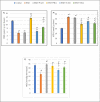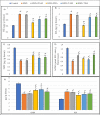Hordeum vulgare ethanolic extract mitigates high salt-induced cerebellum damage via attenuation of oxidative stress, neuroinflammation, and neurochemical alterations in hypertensive rats
- PMID: 37646962
- PMCID: PMC10504167
- DOI: 10.1007/s11011-023-01277-5
Hordeum vulgare ethanolic extract mitigates high salt-induced cerebellum damage via attenuation of oxidative stress, neuroinflammation, and neurochemical alterations in hypertensive rats
Abstract
High salt intake increases inflammatory and oxidative stress responses and causes an imbalance of neurotransmitters involved in the pathogenesis of hypertension that is related to the onset of cerebral injury. Using natural compounds that target oxidative stress and neuroinflammation pathways remains a promising approach for treating neurological diseases. Barley (Hordeum vulgare L.) seeds are rich in protein, fiber, minerals, and phenolic compounds, that exhibit potent neuroprotective effects in various neurodegenerative diseases. Therefore, this work aimed to investigate the efficacy of barley ethanolic extract against a high salt diet (HSD)-induced cerebellum injury in hypertensive rats. Forty-eight Wistar rats were divided into six groups. Group (I) was the control. The second group, the HSD group, was fed a diet containing 8% NaCl. Groups II and III were fed an HSD and simultaneously treated with either amlodipine (1 mg /kg b.wt p.o) or barley extract (1000 mg /kg b.wt p.o) for five weeks. Groups IV and V were fed HSD for five weeks, then administered with either amlodipine or barley extract for another five weeks. The results revealed that barley treatment significantly reduced blood pressure and effectively reduced oxidative stress and inflammation in rat's cerebellum as indicated by higher GSH and nitric oxide levels and lower malondialdehyde, TNF-α, and IL-1ß levels. Additionally, barley restored the balance of neurotransmitters and improved cellular energy performance in the cerebellum of HSD-fed rats. These findings suggest that barley supplementation exerted protective effects against high salt-induced hypertension by an antioxidant, anti-inflammatory, and vasodilating effects and restoring neurochemical alterations.
Keywords: Barley; Cerebellum; Inflammation; Neurotransmitters; Oxidative Stress; Rats.
© 2023. The Author(s).
Conflict of interest statement
The authors have no relevant financial or non-financial interests to disclose.
Figures







Similar articles
-
Cyperus esculentus L. (tigernut) mitigates high salt diet-associated testicular toxicity in Wistar rats by targeting testicular steroidogenesis, oxidative stress and inflammation.Andrologia. 2020 Dec;52(11):e13780. doi: 10.1111/and.13780. Epub 2020 Aug 20. Andrologia. 2020. PMID: 32816391
-
Barley grass juice (Hordeum vulgare L.) inhibits obesity and improves lipid profile in high fat diet-induced rat model.J Ethnopharmacol. 2019 Jun 28;238:111843. doi: 10.1016/j.jep.2019.111843. Epub 2019 Apr 3. J Ethnopharmacol. 2019. PMID: 30951844
-
NaCl stress on physio-biochemical metabolism and antioxidant capacity in germinated hulless barley (Hordeum vulgare L.).J Sci Food Agric. 2019 Mar 15;99(4):1755-1764. doi: 10.1002/jsfa.9365. Epub 2018 Oct 30. J Sci Food Agric. 2019. PMID: 30226277
-
Melatonin prevents kidney injury in a high salt diet-induced hypertension model by decreasing oxidative stress.J Pineal Res. 2016 Jan;60(1):48-54. doi: 10.1111/jpi.12287. Epub 2015 Nov 18. J Pineal Res. 2016. PMID: 26465239
-
Hibiscus sabdariffa (Roselle) calyx: a systematic and meta-analytic review of memory-enhancing, anti-neuroinflammatory and antioxidative activities.Inflammopharmacology. 2023 Feb;31(1):231-240. doi: 10.1007/s10787-022-01101-z. Epub 2022 Nov 27. Inflammopharmacology. 2023. PMID: 36436183 Review.
Cited by
-
Physiological Mechanisms by Which the Functional Ingredients in Beer Impact Human Health.Molecules. 2024 Jun 29;29(13):3110. doi: 10.3390/molecules29133110. Molecules. 2024. PMID: 38999065 Free PMC article. Review.
-
Antihypertensive Effect of Perla and Esmeralda Barley (Hordeum vulgare L.) Sprouts in an Induction Model with L-NAME In Vivo.Metabolites. 2024 Dec 3;14(12):678. doi: 10.3390/metabo14120678. Metabolites. 2024. PMID: 39728459 Free PMC article.
-
Safety classification of herbal medicine use among hypertensive patients: a systematic review and meta-analysis.Front Pharmacol. 2024 May 31;15:1321523. doi: 10.3389/fphar.2024.1321523. eCollection 2024. Front Pharmacol. 2024. PMID: 38881876 Free PMC article.
-
Dietary Antioxidants and Natural Compounds in Preventing Thrombosis and Cardiovascular Disease.Int J Mol Sci. 2024 Oct 25;25(21):11457. doi: 10.3390/ijms252111457. Int J Mol Sci. 2024. PMID: 39519009 Free PMC article. Review.
-
Biological activity of silver nanoparticles synthesized from untapped secondary metabolites of Olea europea endophytic Bacillus amyloliquefaciens.PLoS One. 2025 May 7;20(5):e0321134. doi: 10.1371/journal.pone.0321134. eCollection 2025. PLoS One. 2025. PMID: 40333763 Free PMC article.
References
-
- Biod T, Sirota B, et al. In: Practical clinical biochemistry. 4. Watson A, et al., editors. Prentice-Hall of India Private Ltd: New Delhi; 1948. pp. 142–145.
Publication types
MeSH terms
Substances
LinkOut - more resources
Full Text Sources
Medical

